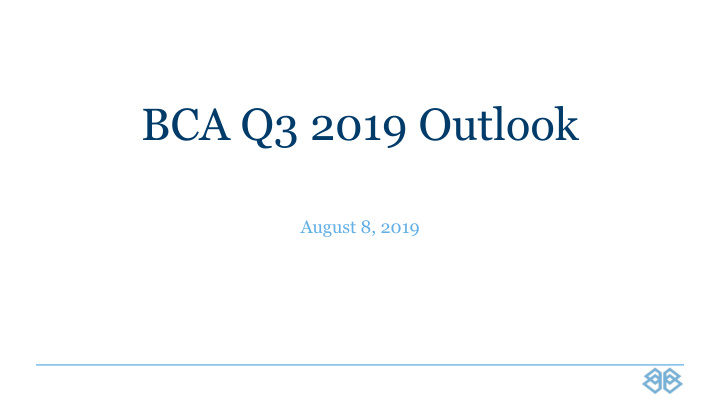



BCA Q3 2019 Outlook August 8, 2019
Disclosures Important Disclosures: This information is for discussion purposes only and is being furnished on August 8, 2019. This information is not to be re-transmitted in whole or in part without the prior consent of Berman Capital Advisors. While all the information prepared in this presentation is believed to be accurate, Berman Capital Advisors makes no express warranty as to its completeness or accuracy nor can it accept responsibility for errors appearing in the presentation. No information provided herein shall constitute, or be construed as, an offer to sell or a solicitation of an offer to acquire any security, investment product or service, nor shall any such security, product or service be offered or sold in any jurisdiction where such an offer or solicitation is prohibited by law or registration. Different types of investments involve varying degrees of risk, and there can be no assurance that the future performance of any specific investment, investment strategy, or product will be profitable or be suitable for your portfolio or individual situation. Please contact Berman Capital Advisors to discuss your individual situation.
Review of First Half Performance Total Index Return Q2 2019 YTD 2019 S&P 500 4.3% 18.5% Russell 1000 Growth 4.6% 21.5% Russell 1000 Value 3.8% 16.2% Russell Small Cap 2.1% 17.0% MSCI EAFE (International) 3.1% 14.5% MSCI Emerging Markets 0.3% 10.8% US Aggregate Bond 3.1% 6.1% High Yield Bonds 2.5% 9.9% Source: Factset Research; data through 6/30/2019 Note: Int'l market returns reported in U.S. Dollars, not local currency • The markets’ reversal from the difficult fourth quarter of last year continued building on the sharp rise last quarter. Last year, of the eight major asset classes tracked by Ned Davis Research, none rose more than 5%. In • this year’s first half, all eight had! Such a rapid shift is quite unusual. • It’s also rare for “risky” stocks and “safe” government bonds to both be performing well. Hope for aggressive central bank action underpins both.
Current Issues in the Market • Following Q4 2018 downdraft, “risk assets” had been supported by the Fed’s easing pivot and a brightening in the ongoing U.S. – China trade conflict. Trade concerns are again front and center, hitting markets hard in recent days. • • Investors, ourselves included, are incrementally more worried about the trade war and it’s impact on confidence. However, we expect a lot of headline-driven back and forth. • Markets in the second half will pay the most attention to 1). Signs of weakness spreading from manufacturing to the rest of the world economy and 2.) How sharply central banks react to counteract signs of weakness. • We think we are in a slowdown but are not yet headed into recession, and that is keeping us “neutral.”
BCA Research Asset Class Views Source: Berman Capital Advisors • We believe the setup for the stock market is fairly positive, in part because investors do not love this rally. We expect the economy to avoid recession, although growth will remain slow. • • Both growth and asset prices will be supported by the global wave of central bank easing now underway. Fiscal policy in the U.S. is also loosening. • Stocks are more attractive than fixed income if the Fed is remotely successful in its campaign to bolster inflation. • The trade situation is back to wait-and-see, but we expect an agreement to eventually be reached.
The Economy
Business Confidence The escalating trade war is exacerbating uncertainty and prompting businesses to hold back investment.
Employment Trends Remain Strong Unemployment claims show the continuing strength of the job market.
Purchasing Manager Indexes (PMI): Services Holding Up Globally, economic weakness is showing up in manufacturing, but not the larger services category.
Further Comments on Manufacturing Weakness
The Financial Markets
Investor Sentiment Investor sentiment has rapidly turned pessimistic, but hasn’t reached oversold extremes.
U.S. Stock Market Valuation Overall, stocks are fairly valued.
It’s a “Growth Style” Market Slow growth, low inflation and tech excitement supporting “Growth” over “Value.”
Stocks vs Bonds: Earnings Yield Minus 10 Year Yield Source: SL Advisors Bond yields are so low that they make equities appear very cheap on a relative basis.
Negative Yields and Central Banks
Markets Concerned About too Low Inflation The market believes the Fed is too • optimistic about the course of future growth and inflation. Even after the expected July cuts, the market will be looking for, and will probably get, more. • On the other hand, we do think the near- consensus view that inflation is dead for the foreseeable future has gone too far and may disappoint bond bulls.
• Negative yields overseas are holding down U.S. rates. Presumably, investors in these bonds expect economic weakness / deflation.
Central Banks Have Room to Ease • Rate cuts are now coming more quickly. Recently Thailand, India and New Zealand all lowered rates. Return to QE and other • unconventional measures are possible.
Takeaways • Equities are likely to be “O.K” given decent fundamentals and new central bank easing cycle. • We expect the economy to enter recession later than market expectations, i.e. not 2020. Both growth and asset prices will be supported by the global wave of central bank easing now underway. • Fiscal discipline has evaporated, which is good for now, bad for later. • Stocks and credit investments will benefit if central banks are able to stave off disinflation. The trade situation will be volatile, but in the end an agreement is more likely than not. • • It’s a fluid situation, and we may take tactical steps to reduce exposure if the outlook changes. • We continue to actively source new, hedged investment ideas.
Thank You
Recommend
More recommend